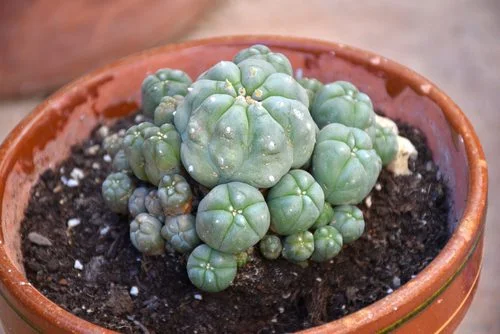Peyote
Peyote or Lophophora williamsii is a small, spineless cactus that is one of the most well-known sources of the hallucinogen substance mescaline. A psychoactive phenethylamine, mescaline produces psychedelic effects similar to lysergic acid diethylamide (LSD) and psilocybin.

Other Names: Buttons, Cactus, Mesc, Mescalito, Peyoto
Along with other classic hallucinogenic drugs like LSD, psilocybin (magic mushrooms), and DMT (N,N-Dimethyltryptamine) in ayahuasca beverage preparations, mescaline in peyote can cause individuals to see images, discern sensations, and perceive sounds that don’t exist but may appear like they were very real.
This profound effect on perception, along with effects on cognition and mood, are due to mescaline being 5-HT (2A) receptor (2AR) agonists.4 5-HT (2A) receptors, in turn, are responsible for managing the neurotransmitter serotonin, which plays a huge part in sensory perception, mood, feelings of well-being, sleep, and body temperature, among others.
Both peyote and mescaline are listed as Schedule I substances under the federal drug scheduling system, which means they have no currently accepted medical use and are technically classified as drugs that have a high potential for abuse.
Why People Use Peyote and Mescaline
Indigenous peoples in southwestern United States and Mexico have used the plant as part of their religious rites for millenia. Studies have shown that native North Americans have already recognized the psychotropic properties of the peyote cactus for at least 5,700 years.
In one study published in the Journal of Ethnopharmacology, radiocarbon dating was performed on archaeological specimens of Lophophora williamsii that were discovered in Shumla Cave No. 5 on the Rio Grande, Texas. The test revealed that the samples date back to between 3,780 and 3,660 BCE.
At present, peyote is illegal to grow and use in the United States. One notable exception is the harvest, possession, consumption and cultivation of the cactus for use in “bona fide religious ceremonies” by members of the Native American Church, as enshrined in the American Indian Religious Freedom Act.
Despite the drug being largely illegal in the United States, many people still use peyote for recreational purposes, desiring the drug for its euphoric effects and its ability to put users in a dream-like trance. However, the effect of hallucinogens can be unpredictable, so it’s possible for users to experience both positive and adverse effects when using peyote.
How Peyote and Mescaline Are Abused
The part of the peyote plant that is typically used are the “buttons,” the disc-shaped parts that are cut off the top of the cactus. This top part of the plant is known as the “crown.”
People who consume peyote do so in one or more of several ways:
- By chewing and ingesting fresh or dried buttons
- By swallowing gelatine capsules that contain dried ground peyote powder
- By soaking buttons in water and drinking the intoxicating liquid
- By smoking with a leaf material such as cannabis or tobacco.
Aside from being a component of the peyote plant, mescaline can also be produced synthetically. This synthesized compound usually comes in powder form.1 Moreover, several other cacti species, including Trichocereus peruvianus and Echinopsis pachanoi also contain mescaline.
Despite peyote and mescaline being illegal, there are still many individuals who secretly consume and distribute them. In 2015, the National Institute of Drug Abuse (NIDA) reported that around 5.5. million Americans, aged 12 or older, have ingested peyote in their lifetime. For mescaline, the figure is 8.8 million individuals.
Immediate Effects of Peyote and Mescaline Abuse
After consuming peyote or mescaline, the individual may experience the following positive emotional and cognitive effects:
- Euphoria
- Enhanced perception and feeling
- Experience of transcendence
- General pleasant sensations
However, consumption of peyote or mescaline is also associated with various other effects. These may include the following:
- Headaches
- Anxiety
- Elevated body temperature
- Sweating
- Rapid heart rate
- High blood pressure
- Muscle weakness
- Impaired motor coordination
- Nausea
- Vomiting
Gastrointestinal symptoms like nausea and vomiting have been associated with ingestion of peyote more than with other methods of mescaline use. It is believed that these symptoms are also caused by other compounds found in the plant other than mescaline.
In addition to the above, consumption of mescaline and peyote have also been shown to produce challenging psychological effects that have been reported to be similar to acute schizophrenia. These may include:
- Sensory alterations
- Ideas of influence
- Paranoia
- Delusions
- Depersonalizations
Long-Term Effects of Peyote and Mescaline Use
The long-term effects of using peyote and mescaline have not been widely studied. However, one recent international epidemiological study published in the Journal of Psychopharmacology has noted that only a few of the people who have participated in the associated survey reported legal problems, psychological challenges, and craving for mescaline. Moreover, none have reported medical difficulties. The researchers were quick to note, however, that definitive safety profiles through medical tests should also be performed in future studies.
This being said, classic hallucinogens have long been associated with two long-term effects:
- Persistent psychosis: This condition can cause symptoms like visual disturbances, paranoia, disorganized thinking, and shifts in mood.
- Hallucinogen persisting perception disorder: These are described as recurrences of drug experiences that may have happened during the last time a person used the substance. Visual disturbances and hallucinations can happen suddenly, days or even many months after drug use.
Is Overdosing on Peyote and Mescaline Possible?
Overdose is more likely to happen among individuals who use high doses of a class of hallucinogens known as dissociative drugs, which include the drug phencyclidine (PCP). On the other hand, classic hallucinogens like mescaline tend to produce only severely unpleasant experiences at elevated doses.
This being said, classic hallucinogens pose a risk of serious harm because of the extreme effects that they could have on a person’s perception and mood. For example, an individual might commit dangerous acts that they would never do if they weren’t intoxicated, like trying to “fly” out from a window or roof, or trying to stop an oncoming train, believing that they were indestructible or invincible.
Symptoms of Peyote and Mescaline Addiction
Although there is only little evidence that peyote or mescaline is addictive, medical professionals will use the same diagnostic criteria that is used for other drugs to diagnose any substance use disorder related to peyote or mescaline use. These 11 symptoms are detailed in the Diagnostic and Statistical Manual of Mental Disorders, 5th Edition (DSM-5):
- Consuming larger amounts of peyote or consuming the drug for longer than intended
- Not being able to stop using peyote despite desiring to limit use
- Spending a lot of time, effort, and resources to obtain and use peyote or to recover from using it
- Developing cravings for peyote
- Inability to manage responsibilities or obligations due to peyote use
- Continuing to use peyote despite it causing relationship issues
- Giving up important activities because of peyote use
- Continuing to use peyote even if it puts one in danger
- Continuing to use peyote despite it making physical or psychological problems worse
- Developing tolerance, which means requiring higher and higher doses of peyote to achieve the same effect
- Developing withdrawal symptoms after abruptly stopping use of peyote
Mescaline Tolerance and Detox
Similar to other psychedelics and classic hallucinogens, peyote and mescaline are known to produce a rapid-onset tolerance period ranging from 3–4 days after consumption. However, despite this potential to generate tolerance in a rapid manner, there is currently no evidence that mescaline can produce physical dependence.
Nevertheless, users may develop a psychological dependence on the drug and may crave for the drug, feeling like they need it to be part of their daily life.9 If you feel like this, consider consulting your doctor or visiting a medical detox facility, who can help you create a plan to address your drug dependence in accordance with the current protocols for hallucinogen detoxification.
Getting Treatment for Peyote and Mescaline Addiction
Abusing peyote or mescaline habitually can impact a person’s life negatively. If you’re one such individual who needs help breaking free from substance use disorder, you should know that there are rehabilitation and treatment centers that can help you. The treatment programs they offer usually come in either of these setups:
- Inpatient peyote addiction treatment: Users struggling with moderate-to-severe addiction or co-occurring conditions can benefit greatly from inpatient treatment. With this treatment setup, you’ll get 24/7 supervision and support from the facility’s medical staff because you will essentially live in the rehab center for the duration of your treatment.
- Outpatient peyote addiction treatment: On the other hand, individuals with mild-to-moderate addiction may opt for outpatient treatment, which offers more freedom by way of being able to live in one’s own home and to carry on with one’s usual day-to-day activities. If your doctor recommends outpatient treatment, you will just be required to attend treatment sessions at the rehab center of your choice.
Currently, there are no FDA-approved medications to treat addiction to peyote and mescaline. Treatments generally focus on addressing symptoms of drug use and counseling the patients on how to effectively cope with their condition. Behavioral treatment is also generally considered helpful, but more research is needed to determine its effectiveness in treating peyote abuse issues.
Call Today to Explore Your Treatment Options
Finding help can be a difficult process, not only because of the inherent challenges posed by addiction but also because there are typically numerous rehab facilities to choose from—each one with its own approach to helping patients heal from substance use disorder. It can also be challenging to get treatment if you’re facing financial difficulties.
At Better Addiction Care, we can help you narrow down your choices and find the best treatment program for your situation. Call us now at (800) 429-7690 to speak to a recovery support advisor. They are well equipped to provide advice about financing your treatment, whether it be through an existing insurance plan you can verify or through other means if you don’t currently have insurance. They can also help you discover affordable and appropriate treatment facilities in your area.
The Origins and Historical Uses of Peyote
For thousands of years, Native Americans have used peyote for ceremonial and ritualistic purposes. People have also long believed that peyote had healing properties, and this belief continues up to this day among many users of the plant. However, there is not enough research to back these claims.
In 1967, the United States’ federal government outlawed peyote and classified it as a Schedule I drug. Mescaline followed in 1970. This means that peyote and mescaline are considered as substances with a high potential for abuse and with no legitimate medicinal purposes. Nevertheless, because of its cultural significance to the Native American community, the American Indian Religious Freedom Act Amendments of 1994 exempted members of the Native American Church from the scheduling. As long as peyote is used in their religious or ritualistic practices, it is not considered illegal.
Despite the restrictions of the federal law concerning peyote and mescaline, recreational use of the drugs continue in the country. Currently, about 1% to 2% of drug users in the United States use peyote. However, since peyote is not always included in research quantifying drug use, it is often difficult to determine the full extent of peyote usage in the country. Call Better Addiction Care today to find a treatment facility for your needs.








